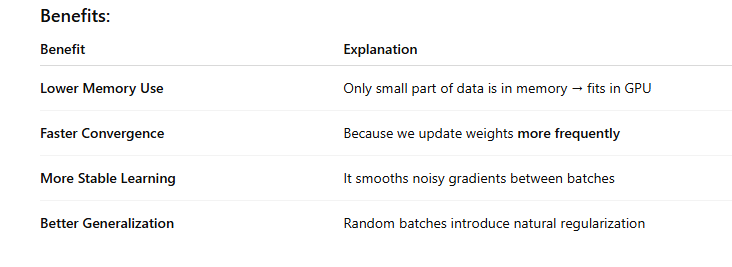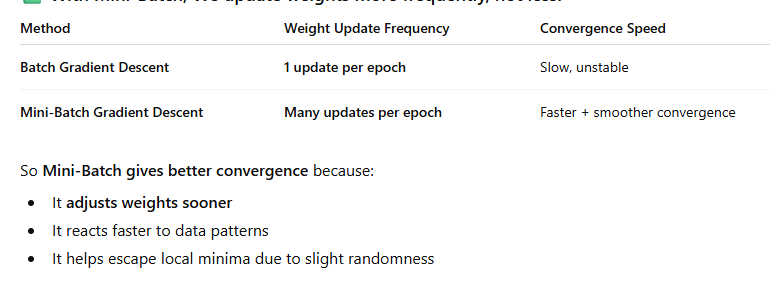Key Benefits
Dataset and DataLoader
Why We Need Dataset and DataLoader in PyTorch
Why Training the Whole Data at Once Is Memory Inefficient
We use Dataset to organize and retrieve samples, and DataLoader to efficiently feed data in mini-batches with shuffling and parallel loading, which reduces memory usage and improves convergence during training.
Key Benefits
Memory Efficient → Only small batches are processed at a time, not the full dataset.
Faster & Smoother Convergence → Because weights are updated multiple times per epoch.
Better Training Performance → Avoids slow & unstable full-batch gradient descent.
Clean & Modular Code → Dataset + DataLoader neatly separates data storage and data feeding.
Dataset
Stores input data and labels in an organized structure.
Allows easy access to any sample using an index (dataset[i]).
Helps handle custom data sources (images, sensors, CSV, video frames, etc.)
Makes it easy to apply transformations (augmentations, normalization).
Supports scalability, since data does not need to be loaded in memory all at once.
DataLoader
Loads data in mini-batches instead of all at once → prevents memory overflow.
Shuffles data to prevent the model from learning order patterns.
Enables parallel data loading using workers → speeds up training.
Feeds data to the model sequentially & efficiently each training step.
Essential for mini-batch gradient descent, which improves convergence and training stability.
Why We Need Dataset and DataLoader in PyTorch
If you have 10GB dataset, you cannot load all of it into GPU memory at once.
So DataLoader loads only a small batch at a time → avoiding memory overflow.
from torch.utils.data import DataLoader, Dataset
class MyDataset(Dataset):
def __init__(self, X, y):
self.X = X
self.y = y
def __len__(self):
return len(self.X)
def __getitem__(self, idx):
return self.X[idx], self.y[idx]
dataset = MyDataset(X, y)
loader = DataLoader(dataset, batch_size=32, shuffle=True)
Why Training the Whole Data at Once Is Memory Inefficient
This method is called Batch Gradient Descent.
We compute loss on entire dataset before updating weights.
If dataset is huge → GPU RAM will overflow
Also 1 update per full data = slow learning
So this is BAD for deep learning.
✅ Why We Use Mini-Batch Gradient Descent (with DataLoader)
Mini-Batch means:
Process small chunks (like 32, 64 samples)
Update weights after each batch
⭐ Key Point About Better Convergence
You said:
"we are not updating weights after backward frequently so we use mini batch"
Actually the correct version is:
DataLoader loads data in mini-batches so the model can train without loading everything into memory.
Mini-batch gradient descent updates weights more frequently, which leads to faster and smoother convergence than batch gradient descent.
This also avoids memory overflow and improves training stability.
🎯 One-Line Answer
Dataset organizes data, DataLoader feeds it in mini-batches to avoid memory issues. Mini-batches allow frequent weight updates, which gives faster and more stable convergence in training.
Batch Gradient Descent (memory inefficient, slow convergence)
Mini-Batch Gradient Descent using DataLoader (memory efficient, faster convergence)
🧠 Step 1: Create a Synthetic Dataset
import torch
from torch.utils.data import Dataset, DataLoader
# Creating Fake Dataset (1000 samples, each sample has 3 features)
X = torch.randn(1000, 3)
y = (X.sum(dim=1) > 0).long() # Binary labels based on feature sum
class MyDataset(Dataset):
def __init__(self, X, y):
self.X = X
self.y = y
def __len__(self):
return len(self.X)
def __getitem__(self, idx):
return self.X[idx], self.y[idx]
dataset = MyDataset(X, y)
🚫 Case 1: Batch Gradient Descent (All data at once → Memory inefficient)
# Simple model
model = torch.nn.Sequential(
torch.nn.Linear(3, 2)
)
loss_fn = torch.nn.CrossEntropyLoss()
optimizer = torch.optim.SGD(model.parameters(), lr=0.1)
# Training using *full batch*
for epoch in range(5):
# forward on entire dataset
y_pred = model(X)
loss = loss_fn(y_pred, y)
optimizer.zero_grad()
loss.backward() # compute gradients
optimizer.step() # update weights (only once per epoch)
print(f"Epoch {epoch+1}: Loss = {loss.item():.4f}")
❗ Problem:
Loads all 1000 samples into GPU for each computation
Only 1 update per epoch → slow learning → bad convergence
✅ Case 2: Mini-Batch Gradient Descent using DataLoader (Efficient + Better Convergence)
# Make DataLoader to load mini-batches of 32 samples
loader = DataLoader(dataset, batch_size=32, shuffle=True)
model = torch.nn.Sequential(
torch.nn.Linear(3, 2)
)
loss_fn = torch.nn.CrossEntropyLoss()
optimizer = torch.optim.SGD(model.parameters(), lr=0.1)
# Training using mini-batches
for epoch in range(5):
for batch_X, batch_y in loader:
y_pred = model(batch_X)
loss = loss_fn(y_pred, batch_y)
optimizer.zero_grad()
loss.backward() # gradients calculated per batch
optimizer.step() # weights updated many times per epoch
print(f"Epoch {epoch+1}: Last Batch Loss = {loss.item():.4f}")
FULL CODING
import torch
from torch.utils.data import Dataset, DataLoader
# =========================
# 1) Create Synthetic Dataset
# =========================
# 1000 samples, each with 3 features
X = torch.randn(1000, 3)
y = (X.sum(dim=1) > 0).long() # Label 1 if sum > 0 else 0
# Custom Dataset Class
class MyDataset(Dataset):
def __init__(self, X, y):
self.X = X
self.y = y
def __len__(self):
return len(self.X)
def __getitem__(self, idx):
return self.X[idx], self.y[idx]
dataset = MyDataset(X, y)
# Simple Model for Demonstration
def create_model():
return torch.nn.Sequential(
torch.nn.Linear(3, 2) # 3 input features → 2 output classes
)
# =============================================
# 2) TRAINING USING BATCH GRADIENT DESCENT (BAD)
# =============================================
print("\n===== TRAINING WITH BATCH GRADIENT DESCENT (Memory Inefficient, Slow Updates) =====")
model = create_model()
loss_fn = torch.nn.CrossEntropyLoss()
optimizer = torch.optim.SGD(model.parameters(), lr=0.1)
for epoch in range(5):
y_pred = model(X) # Forward on **entire dataset at once**
loss = loss_fn(y_pred, y)
optimizer.zero_grad()
loss.backward() # Compute gradients
optimizer.step() # Update weights **only once per epoch**
print(f"Epoch {epoch+1}: Loss = {loss.item():.4f}")
# Explanation:
# - Uses whole dataset each step -> HIGH memory usage
# - Weight updates happen rarely -> Slow convergence
# ===============================================
# 3) TRAINING USING MINI-BATCH WITH DATALOADER (GOOD)
# ===============================================
print("\n===== TRAINING WITH MINI-BATCH GRADIENT DESCENT (Efficient + Better Convergence) =====")
# Create DataLoader to load small batches (32 samples per batch)
loader = DataLoader(dataset, batch_size=32, shuffle=True)
model = create_model() # Reset model
loss_fn = torch.nn.CrossEntropyLoss()
optimizer = torch.optim.SGD(model.parameters(), lr=0.1)
for epoch in range(5):
for batch_X, batch_y in loader:
y_pred = model(batch_X)
loss = loss_fn(y_pred, batch_y)
optimizer.zero_grad()
loss.backward() # Gradients for this batch
optimizer.step() # Weights updated **multiple times per epoch**
print(f"Epoch {epoch+1}: Last Batch Loss = {loss.item():.4f}")
# Explanation:
# - Loads only **a small batch at a time** -> Saves memory
# - Weight updates happen MANY times per epoch -> Faster & smoother convergence
# =========================
# Final Takeaway (Printed)
# =========================
print("\n================= SUMMARY =================")
print("Batch Gradient Descent: High memory use + slow convergence (only 1 update per epoch).")
print("Mini-Batch using DataLoader: Low memory use + faster convergence (many updates per epoch).")
print("Thus DataLoader helps training deep models efficiently and stably.")






Top comments (0)